
A molecular cloud, sometimes called a stellar nursery (if star formation is occurring within), is a type of interstellar cloud, the density and size of which permit the formation of molecules, most commonly molecular hydrogen (H2). This is in contrast to other areas of the interstellar medium that contain predominantly ionized gas.

A nebula is an interstellar cloud of dust, hydrogen, helium and other ionized gases. Originally, the term was used to describe any diffuse astronomical object, including galaxies beyond the Milky Way. The Andromeda Galaxy, for instance, was once referred to as the Andromeda Nebula before the true nature of galaxies was confirmed in the early 20th century by Vesto Slipher, Edwin Hubble and others.
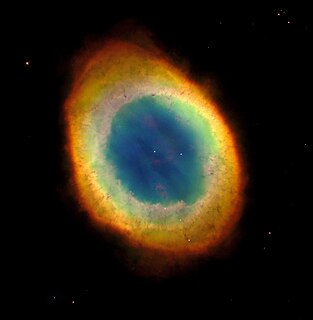
The Ring Nebula is a planetary nebula in the northern constellation of Lyra. Such objects are formed when a shell of ionized gas is expelled into the surrounding interstellar medium by a star at the end of its asymptotic giant branch phase, in the last stages of its evolution before becoming a white dwarf.

In astronomy, reflection nebulae are clouds of interstellar dust which might reflect the light of a nearby star or stars. The energy from the nearby stars is insufficient to ionize the gas of the nebula to create an emission nebula, but is enough to give sufficient scattering to make the dust visible. Thus, the frequency spectrum shown by reflection nebulae is similar to that of the illuminating stars. Among the microscopic particles responsible for the scattering are carbon compounds and compounds of other elements such as iron and nickel. The latter two are often aligned with the galactic magnetic field and cause the scattered light to be slightly polarized.
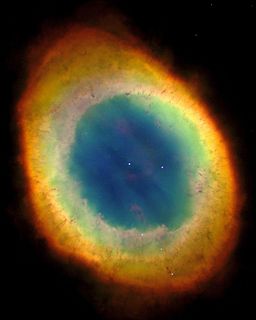
An emission nebula is a nebula formed of ionized gases that emit light of various wavelengths. The most common source of ionization is high-energy photons emitted from a nearby hot star. Among the several different types of emission nebulae are H II regions, in which star formation is taking place and young, massive stars are the source of the ionizing photons; and planetary nebulae, in which a dying star has thrown off its outer layers, with the exposed hot core then ionizing them.

The Orion Nebula is a diffuse nebula situated in the Milky Way, being south of Orion's Belt in the constellation of Orion. It is one of the brightest nebulae, and is visible to the naked eye in the night sky. M42 is located at a distance of 1,344 ± 20 light years and is the closest region of massive star formation to Earth. The M42 nebula is estimated to be 24 light years across. It has a mass of about 2,000 times that of the Sun. Older texts frequently refer to the Orion Nebula as the Great Nebula in Orion or the Great Orion Nebula.

An H II region or HII region is a region of interstellar atomic hydrogen that is ionized. It is typically a cloud of partially ionized gas in which star formation has recently taken place, with a size ranging from one to hundreds of light years, and density from a few to about a million particles per cubic cm. The Orion Nebula, now known to be an H II region, was observed in 1610 by Nicolas-Claude Fabri de Peiresc by telescope, the first such object discovered.

The Cat's Eye Nebula or NGC 6543, is a relatively bright planetary nebula in the northern constellation of Draco, discovered by William Herschel on February 15, 1786. It was the first planetary nebula whose spectrum was investigated by the English amateur astronomer William Huggins, demonstrating that planetary nebulae were gaseous and not stellar in nature. Structurally, the object has had high-resolution images by the Hubble Space Telescope revealing knots, jets, bubbles and complex arcs, being illuminated by the central hot planetary nebula nucleus (PNN). It is a well-studied object that has been observed from radio to X-ray wavelengths.

The Calabash Nebula, also known as the Rotten Egg Nebula or by its technical name OH 231.84 +4.22, is a protoplanetary nebula (PPN) 1.4 light years long and located some 5,000 light years from Earth in the constellation Puppis. The name "Calabash Nebula" was first proposed in 1989 in an early paper on the expected nebular dynamics, based on the nebula's appearance The Calabash is an almost certain member of the open cluster Messier 46, as it has the same distance, radial velocity, and proper motion.

The Stingray Nebula is the youngest known planetary nebula (PN). The Stingray is located in the direction of the southern constellation Ara, and is located 18,000 light-years away. Although it is some 130 times the size of the Solar System, the Stingray Nebula is only about 1/10 the size of most other known planetary nebulae. Until approximately forty years ago, it was observed on Earth as a protoplanetary nebula in which the gas had not yet become hot and ionized. In a Nature article, Bobrowsky et al. described how the Hubble observations revealed a 17th-magnitude companion to the Stingray's 15th-magnitude central star. The image of the Stingray Nebula shown here shows how the outer shells of gas are collimating the continuing outflow of gas from the central star—an important observation, as the process of how these outflows become collimated has not been well understood.
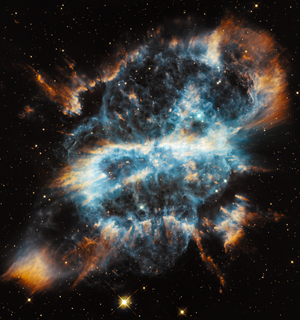
NGC 5189 is a planetary nebula in the constellation Musca. It was discovered by James Dunlop on 1 July 1826, who catalogued it as Δ252. For many years, well into the 1960s, it was thought to be a bright emission nebula. It was Karl Gordon Henize in 1967 who first described NGC 5189 as quasi-planetary based on its spectral emissions.

Herbig–Haro (HH) objects are bright patches of nebulosity associated with newborn stars. They are formed when narrow jets of partially ionized gas ejected by said stars collide with nearby clouds of gas and dust at speeds of several hundred kilometers per second. Herbig–Haro objects are commonly found in star-forming regions, and several are often seen around a single star, aligned with its rotational axis. Most of them lie within about one parsec of the source, although some have been observed several parsecs away. HH objects are transient phenomena that last around a few tens of thousands of years. They can change visibly over quite short timescales of a few years as they move rapidly away from their parent star into the gas clouds of interstellar space. Hubble Space Telescope observations have revealed the complex evolution of HH objects over the period of a few years, as parts of the nebula fade while others brighten as they collide with the clumpy material of the interstellar medium.

NGC 7027 is a very young and dense planetary nebula located around 3,000 light-years from Earth in the constellation Cygnus. Discovered in 1878 by Édouard Stephan using the 800 mm (31 in) reflector at Marseille Observatory, it is one of the smallest planetary nebulae and by far the most extensively studied. Helium hydride was detected in the nebula in 2019, the first discovery of that molecule in space.

A protoplanetary nebula or preplanetary nebula (PPN) is an astronomical object which is at the short-lived episode during a star's rapid evolution between the late asymptotic giant branch (LAGB) phase and the subsequent planetary nebula (PN) phase. A PPN emits strongly in infrared radiation, and is a kind of reflection nebula. It is the second-from-the-last high-luminosity evolution phase in the life cycle of intermediate-mass stars.

An ice giant is a giant planet composed mainly of elements heavier than hydrogen and helium, such as oxygen, carbon, nitrogen, and sulfur. There are two ice giants in the Solar System: Uranus and Neptune.
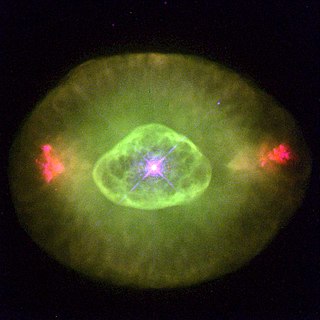
NGC 6826 is a planetary nebula located in the constellation Cygnus. It is commonly referred to as the "blinking planetary", although many other nebulae exhibit such "blinking". When viewed through a small telescope, the brightness of the central star overwhelms the eye when viewed directly, obscuring the surrounding nebula. However, it can be viewed well using averted vision, which causes it to "blink" in and out of view as the observer's eye wanders.
Photodissociation regions are predominantly neutral regions of the interstellar medium in which far ultraviolet photons strongly influence the gas chemistry and act as the most important source of heat. They occur in any region of interstellar gas that is dense and cold enough to remain neutral, but that has too low a column density to prevent the penetration of far-UV photons from distant, massive stars. A typical and well-studied example is the gas at the boundary of a giant molecular cloud. PDRs are also associated with HII regions, reflection nebulae, active galactic nuclei, and Planetary nebulae. All the atomic gas and most of the molecular gas in the galaxy is found in PDRs.
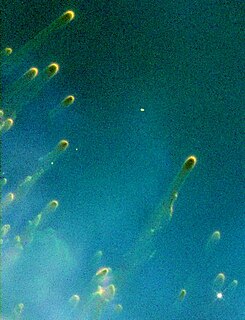
Cometary knots are structures observed in several nearby planetary nebulae, including the Helix Nebula, the Ring Nebula, the Dumbbell Nebula, the Eskimo Nebula, and the Retina Nebula. It is believed that they are a common feature of the evolution of planetary nebulae, but can only be resolved in the nearest examples. They are generally larger than the size of the Solar system, with masses comparable to that of the Earth.
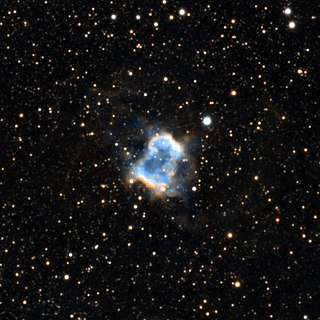
NGC 6445, also known as the Little Gem Nebula or Box Nebula, is a planetary nebula in the constellation Sagittarius. It was discovered by William Herschel on May 28, 1786. The distance of NGC 6445 is estimated to be slightly more than 1,000 parsecs based on the parallax measured by Gaia, which was measured at 0.9740±0.3151 mas.


















